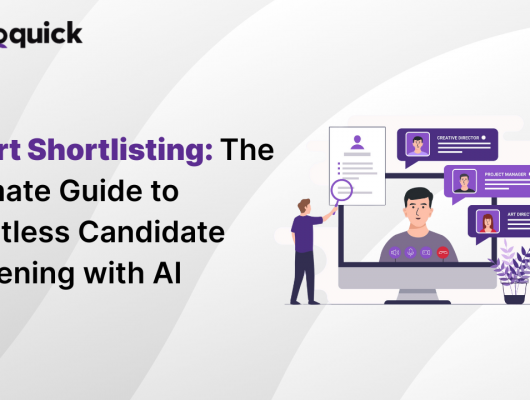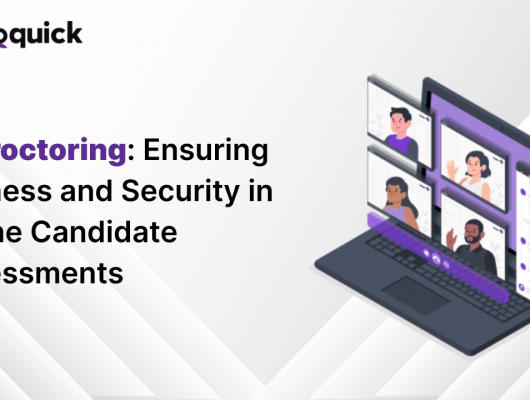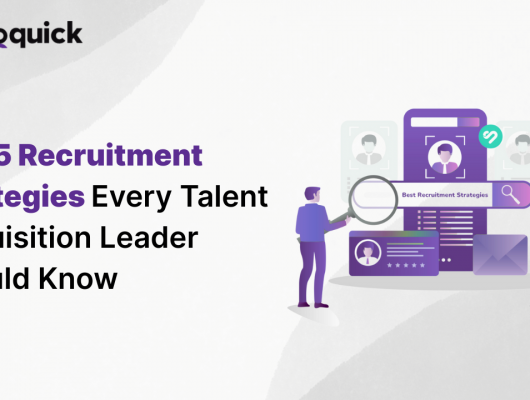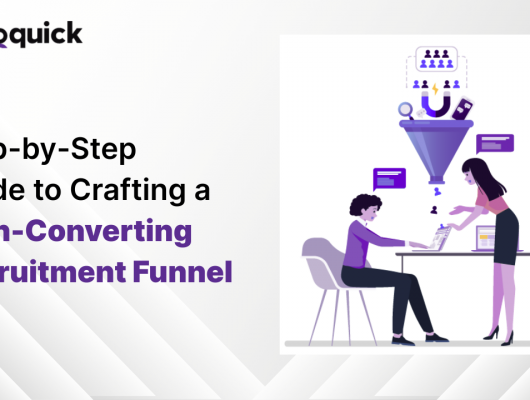You know, in today’s hiring world, it really feels like candidates are looking at companies almost like customers. They expect things to be clear, straightforward, and honestly, they want to feel respected right from the very beginning. I mean, the race for great people isn’t just about how much you pay anymore. It’s become hugely about what kind of reputation your company has, and how you treat folks even before they’re officially part of the team.
Now, lots of companies put a ton of effort into showing off their culture, talking about their values, highlighting benefits – basically marketing that ideal employer brand, right? But here’s the thing, and maybe you’ve seen this too: that carefully built picture can fall apart pretty fast if the actual hiring experience doesn’t match up. If applying feels clunky, if communication is slow, or if things just feel… impersonal, well, all that positive messaging can kind of get washed away. It definitely hurts your employer brand, and it pushes away people you really wanted to bring in. I read something recently, I think it was from LinkedIn, that said a huge number of job seekers, maybe around 75%, look at an employer’s brand before they even apply. check for more. So, yeah, a rough candidate experience can really mess things up.
So, maybe the way to think about this is that your hiring process isn’t just about filling open spots. It’s actually one of the most important times your company gets to connect with potential employees and really show them what you’re about. By thinking deliberately about each step, about how you customize that journey for candidates, you can build an experience that genuinely reflects your values, strengthens your brand identity, and, hopefully, helps you attract just the right kind of talent. This piece, hopefully, will walk you through why this connection matters so much, how to figure out where you can do better, and some practical ideas for making your process more impactful.
Why Your Hiring Process IS Your Employer Branding Strategy
If you only see your hiring process as, you know, just the way to get people into roles, you might be missing something big. Every single time a candidate interacts with your company – from seeing a job ad, to maybe getting (or not getting) that final email – that’s a direct look at your brand. It’s like a live performance of your culture, what you value, and frankly, how you actually treat people. Thinking about it this way makes the candidate journey a really powerful, and maybe sometimes overlooked, part of your whole employer branding effort.
The Candidate Journey: A Series of Brand Touchpoints
Just think about what a candidate typically goes through. It usually starts with hearing about you somehow – maybe online, from a friend, or finding an open job. Then comes getting interested, applying, talking to someone to see if it’s a fit, maybe some interviews, possibly an assessment, getting an offer, and then either starting the job or getting that rejection notice. At each one of these points, there are chances to either make your desired employer brand stronger or completely undermine it. A confusing application form, waiting forever for a reply, or an interviewer who seems totally unprepared… that honestly tells candidates a lot about your organization. Sometimes it speaks louder than all your polished marketing materials. And negative stories? Yeah, those spread fast, especially with social media and sites like Glassdoor. It definitely hurts how people see your company.
The Tangible ROI of a Strong Employer Brand & Great CX
Now, the good things that come from giving candidates a positive experience, especially one that feels personalized, go way beyond just filling roles. There’s actually a measurable return on investment here. Companies with a strong employer brand often see lower costs per hire, maybe by as much as 50%, and things tend to move faster, possibly even twice as fast. Those are numbers you see mentioned in HR reports quite a bit.
A positive experience also seems to lead to more people saying yes to offers, and it can even influence the caliber of candidates who decide to apply in the first place. Plus, when new hires had a great candidate experience, they often start feeling more connected and engaged right from day one, and that can really help with keeping people around for longer. So, being proactive about the hiring experience is a pretty central part of managing your employer brand effectively.
Laying the Foundation: Understanding Your Employer Brand
Before you can even think about making your hiring process reflect your employer brand, you really need to have a clear, honest idea of what that brand actually is. It’s pretty easy to come up with a catchy slogan or some nice-sounding values, but your real employer brand? That’s basically what your current employees experience and think every day. It’s the reality of working inside your company.
Defining Your Authentic Employer Brand
Your employer brand is tied up really closely with your company culture, how the leaders act, the kind of work environment you have, chances for people to grow, and just generally how valued employees feel. It’s not just something marketing comes up with. It’s about making sure what people see from the outside matches the reality on the inside. To figure out what your authentic brand is, it helps to ask the people who work there now. Use surveys, maybe some focus groups, look at exit interviews. And don’t forget to look outside too, see what current and former employees are saying on review sites like Glassdoor or on social media. Getting an honest picture is really the first step for any meaningful employer branding plan.
Employer Brand Management: More Than Just Marketing
Managing your employer brand properly is, I think, an ongoing thing. It means actually living your brand inside the company and then showing that reality consistently to the outside world. Marketing definitely helps get the word out, sure, but most of the real work happens through actions. Especially in how you find, bring in, and manage people. Your recruitment team and the hiring managers? They are basically the face of your brand during hiring. How they act and the process they run are tangible examples of your employer brand. Good management means making sure the experience candidates have looks a lot like the reality employees live.
The Candidate Journey Map: Identifying Customization Opportunities
To actually make your hiring process feel customized, you really need to try and see it from the candidate’s point of view. Mapping out the candidate journey is a crucial step, absolutely. It helps you see everything they go through, spot where things might be tricky, and find chances to weave in your employer brand throughout the experience.
Mapping Your Current Candidate Experience
A good place to start is just listing out every single step a candidate takes, from the very first time they even hear about your company as a place to work, all the way up to their first day (or getting that final message if they weren’t chosen).
Here’s a simple way to think about mapping that out:
- First, identify the main stages. You know, like Awareness, Application, talking to someone, Interviews, maybe getting an Offer, and then either Onboarding or getting a Rejection.
- Within each of those stages, list out every little interaction point. That could be seeing an ad on a job board, looking at your career site, filling out the application form, getting that confirmation email, the first screening call, scheduling the interview, the interview itself, a follow-up email, any assessments, the offer letter, that rejection notice, or maybe accessing the onboarding system.
- For each interaction point, try to think about: What’s the candidate probably thinking? How are they feeling? What are they doing? What information do they really need right then? And where could things potentially get difficult or frustrating for them?
- It’s super helpful to talk to people who’ve recently gone through the process, whether you hired them or not. And talk to the hiring teams too. That helps make sure what you think is happening actually lines up with the reality and helps you find those real pain points.
Aligning the Journey with Your Employer Brand Promise
Once you have that map, put your company’s authentic employer brand values and culture right on top of it. Ask yourselves things like:
- Where in our current process do we feel like we’re actually doing a good job of showing our brand?
- Where are we maybe falling short? Where are we not really delivering on what we say we’re about?
- Are there places where we could more actively show our values and culture at each stage?
This kind of analysis really helps you move past just having a standard hiring process towards one that feels more specific and customized. It helps reinforce who you are and strengthens your overall employer branding approach.
Customizing Each Stage: Building Brand Through Experience
Okay, this is where the rubber meets the road, you could say. By really thinking about and designing the candidate experience at every single interaction point, you turn your hiring process into something powerful for building your employer brand. Each step offers different ways to make it feel more personal and branded.
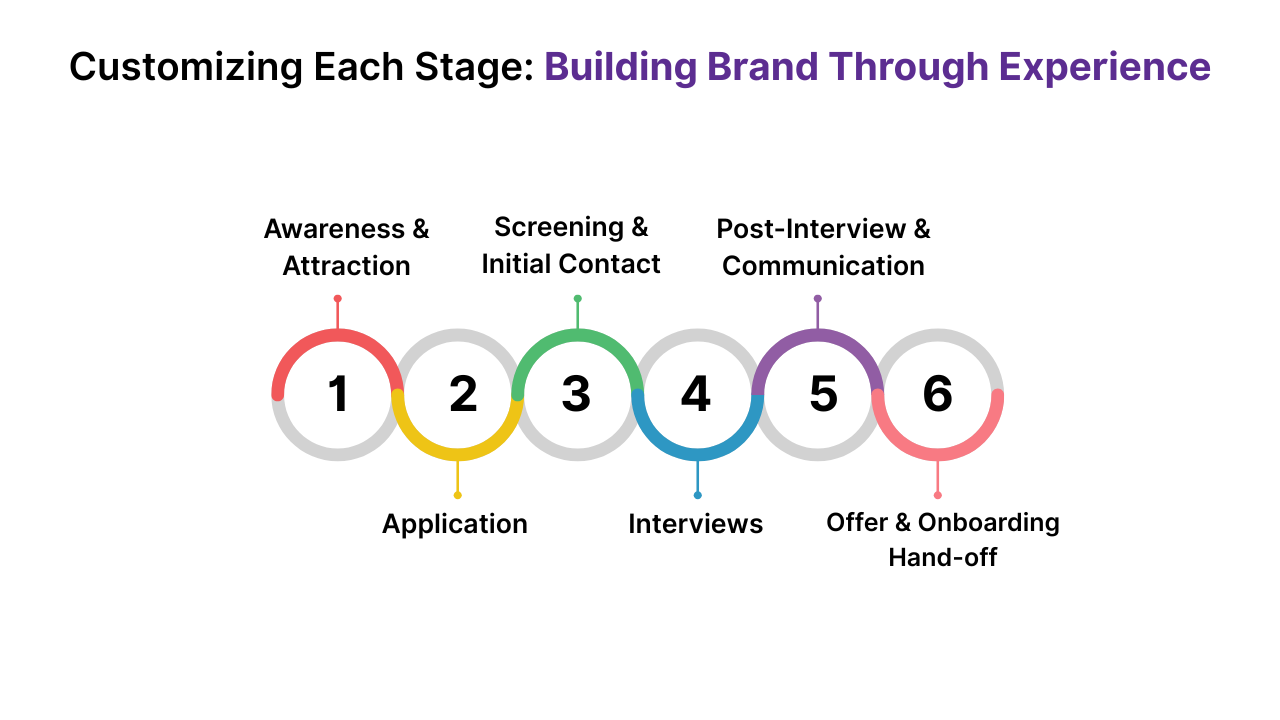
Stage 1: Awareness & Attraction
This is often the very first time candidates really think of your company as a place they might work. It’s that initial impression.
- Things to definitely do:
Write job descriptions that do more than just list requirements. Try to make them reflect your company culture and maybe a bit about the team. Use language that sounds like your company.
If you’re reaching out to people directly, try to make it specific. Instead of sending out a bunch of generic emails, tell passive candidates why you thought they might be a good fit based on what you saw, and how the job could line up with what they want to do next.
Make sure your career site works well on phones, is easy to find things on, and really shows your authentic employer brand. Maybe include quotes from employees, some photos, or even short videos.
If diversity, equity, and inclusion are genuinely important to your brand, make sure that’s clear.
- Things you really should try to avoid:
Using those super generic job descriptions that, honestly, could be for any company anywhere.
Sending out mass messages that feel like you’re just hoping someone, anyone, applies.
Having a career page that’s outdated or hard to find on your website.
Saying you have a certain culture or benefits if that’s not actually the case.
Stage 2: Application
Applying itself can be a big hurdle for people, or it could be a chance to make a good impression.
- Things to definitely do:
Make the application form easy to use, mobile-friendly, and only ask for stuff you absolutely need at this first stage. Seriously, just the essentials.
Give clear instructions and maybe even an idea of how long it should take to fill out.
Send an immediate email confirming you got their application. Make it sound like a person wrote it, thank them for their time, and tell them clearly what happens next and roughly when.
Maybe mention how their information will be handled; that builds trust, I think.
Using technology that helps make applications smoother and sends automatic acknowledgements can really make a difference for candidates.
- Things you really should try to avoid:
Asking for the same information that’s already on their resume or their LinkedIn profile. It’s just frustrating.
Having a super long, complicated, or glitchy application form.
Leaving candidates completely in the dark after they apply, making them wonder if you even got it.
Making people do extra work that doesn’t seem necessary for the job (like writing a whole cover letter for a role where it’s not really needed).
Stage 3: Screening & Initial Contact
Moving quickly, being professional, and adding that personal touch are really important here.
- Things to definitely do:
Get back to qualified candidates relatively fast. The quicker you are, the more they feel like you actually value their interest.
When you reach out, whether it’s an email or a call, try to make it specific to them and the job they applied for. Mention something from their application.
Clearly explain what the next steps are. Tell them about timelines, who they might be talking to, and generally what the interview stages will involve.
Technology can help here too. Automated screening support or personalized templates for emails and texts can keep things efficient while still feeling personal.
- Things you really should try to avoid:
Taking weeks and weeks to reply. Or, worse, not replying at all. That whole “application black hole” is a bad experience.
Sending out generic form emails that sound like they’re sent to everyone.
Leaving candidates unsure about what the rest of the process looks like.
Stage 4: Interviews
The people doing the interviews are probably the most visible representatives of your employer brand that a candidate will meet.
- Things to definitely do:
Train your interviewers! Make sure they understand their role as brand ambassadors. They should know your company culture, your values, and be ready to share positive things about working there.
Give interviewers all the relevant information about the candidate beforehand. Please don’t make candidates repeat everything.
Make interviews feel like a conversation that goes both ways. Give candidates plenty of time to ask their questions about the job, the team, and what the culture is really like.
Maybe include a few questions that help you see if a candidate seems like a good fit for your culture and values, alongside assessing their skills.
Ask candidates how their interview experience was. Seriously, that feedback is gold for figuring out what’s working and what’s not.
If you use assessments, make sure they feel relevant and are explained clearly. Tools that help create customized assessments or manage things like ethical proctoring can help this stage feel smoother.
- Things you really should try to avoid:
Interviewers showing up late, seeming unprepared, or just looking plain bored. That’s a terrible look.
Asking the same questions over and over, making candidates feel like they’re being grilled.
Not giving candidates a chance to ask their own questions.
Having different interviewers describe the company or the role in completely different, maybe even conflicting, ways.
Stage 5: Post-Interview & Communication
What happens after the interview is super important, especially for people you aren’t going to hire.
- Things to definitely do:
Update candidates on their status relatively quickly, even if you just have to say, “We’re still deciding.” Managing expectations is key.
Send clear messages to everyone who interviewed, whether they’re moving forward or not. Make it timely and, ideally, a bit personalized.
For candidates who aren’t chosen, send them a polite rejection notice. Make it sound like you appreciate their time. If you can, and it feels appropriate for the role, maybe offer a tiny bit of general, constructive feedback. This helps keep a positive feeling, and that person might even apply again for something else later, or maybe they’ll become a customer.
Using automated features for follow-ups and notifications can help ensure no one gets forgotten, but try to make those messages feel as personalized as possible using templates.
- Things you really should try to avoid:
Going completely silent after the interview. “Ghosting” candidates is just not okay.
Sending out generic, cold rejection emails that clearly came from a system and feel totally impersonal.
Making candidates have to chase you down for updates.
Stage 6: Offer & Onboarding Hand-off
These last steps should really build on the good experience they’ve hopefully had so far.
- Things to definitely do:
Make the offer feel special. Maybe start with a quick congratulatory phone call before sending the formal letter. Make the offer letter easy to understand.
Keep in touch with the person between the time they say yes to the offer and their actual start date. Welcome them, give them necessary info ahead of time, maybe introduce them to their team somehow (virtually or in person).
Make sure there’s a smooth transition from the hiring team to the people who handle onboarding. No dropping the ball here.
Technology that helps manage the offer process and connects with your onboarding systems really helps make this transition feel seamless for the new hire.
- Things you really should try to avoid:
Just sending an offer letter out of the blue without talking to them first.
Going quiet after they accept the offer. You don’t want them to start feeling disconnected before they even join.
Having their first day or first week feel totally disorganized or confusing.
Leveraging Technology: Enabling Personalized, Scalable CX
Okay, let’s be real, trying to give every single candidate a great, personalized experience when you’re dealing with potentially a lot of applications is tough without the right tools. Modern hiring technology isn’t just about being more efficient, though it definitely helps with that. It’s actually a key part of making your employer branding strategy work.
The ATS as Your Employer Brand Engine
Your Applicant Tracking System, or ATS, should ideally be central to your efforts to build a strong, branded candidate experience. A good one lets you automate routine communication while still making it feel personal, keeps candidate information organized, and helps you track all your interactions. When you’re looking at or using an ATS, think about features like:
- Custom Branding: Can you make sure your career site and emails to candidates visually match your company’s look and feel?
- Automated Communications: Can you set up personalized emails or texts to go out at important times – like when an application is received, or they move to the next stage, or an interview is scheduled?
- Candidate Management: Does it keep all the candidate info and interaction history in one easy-to-access place for your team?
- Reporting & Analytics: Can you track things like how satisfied candidates are or how quickly you’re getting back to people?
- AI Features: Some tools now have AI that can help with things like suggesting interview questions or processing resumes faster. This can make the process quicker and more relevant for candidates, and it frees up recruiters to spend time on personalization.
These sorts of capabilities really let you put those customized strategies we talked about into practice consistently, and efficiently. It turns your ATS from just a database into something that actively helps build your employer brand.
Integrating Tools for a Seamless Experience
Think beyond just the main ATS too. It’s worth looking at integrating it with other HR tools you use. Connecting your ATS with, say, assessment platforms (maybe those that let you customize the questions or how they’re presented), your HR system for onboarding, and communication tools helps everything flow smoothly. It means a more consistent experience for candidates as they move through different stages and eventually become employees. A bunch of disconnected systems can really lead to a disconnected candidate experience.
Measuring Success: Tracking Employer Brand & CX KPIs
Okay, you’ve probably heard this before, but you really can’t manage something if you’re not measuring it. To know if your efforts to customize the hiring process and improve the candidate experience are actually working for your employer brand, you need to keep an eye on the right numbers, or KPIs.
Key Metrics for Candidate Experience
These numbers give you direct insight into what candidates think about your process:
- Candidate Satisfaction Scores (CSAT): You can get this by asking candidates how they felt in a quick survey after applying or interviewing.
- Candidate Net Promoter Score (CNPS): This is asking candidates if they’d recommend someone else apply to your company.
- Application Completion Rate: If lots of people start but don’t finish your application, that tells you there’s friction somewhere.
- Time to Communicate Status: How long does it take on average between stages, or after interviews, to let people know what’s happening?
- Candidate Feedback Themes: Look at what people are saying in those surveys or on review sites. Are the same issues coming up?
Key Metrics for Employer Brand Health
These metrics give you a wider view of how your focus on CX and branding is impacting things:
- Review Site Ratings & Sentiment: What are people saying about your company, especially the hiring process, on sites like Glassdoor or Indeed?
- Career Page Traffic & Conversion: How many people visit your career page, and what percentage of them actually apply?
- Application Volume & Quality: Are you getting more applications? And, maybe more importantly, are the quality of candidates applying getting better?
- Offer Acceptance Rate: When you make an offer, how often do people say yes? A high rate usually means candidates really want to work for you.
- Cost Per Hire: Sometimes, a smoother process and a stronger brand can actually lower the cost it takes to hire someone.
- Quality of Hire: Are the people you’re bringing in turning out to be high performers and staying with the company?
- Employee Referral Rate: Are your current employees confident enough in the company (and the hiring process) to recommend applying to their friends?
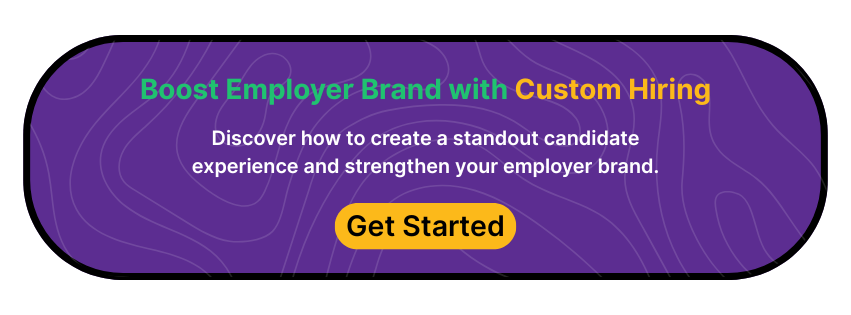
Connecting CX Metrics to Brand Outcomes
The real goal here is to see how getting better at those candidate experience metrics actually helps improve those broader employer brand health metrics. For example, if your candidate satisfaction scores go up after interviews, you might start seeing better ratings for the interview process on Glassdoor, and perhaps more people accepting offers. Using data from your ATS and other places helps you see these connections and, importantly, show that investing in a better candidate experience as part of your employer branding strategy is really paying off.
| Candidate Experience Metric | Potential Employer Brand Impact |
| Candidates are more satisfied | You might see more positive reviews online, your reputation looks better |
| You communicate quickly | People see you as professional, it shows you respect their time |
| Process expectations are clear | Candidates feel less anxious, it helps build trust |
| Application is easy to complete | First impression is good, more people finish applying |
| Rejections are personalized | Keeps things positive, they might apply again or become a customer |
Overcoming Challenges in Building a Branded CX
Now, changing your hiring process to make the candidate experience better isn’t always easy. There are definitely hurdles. Getting everyone on board, not having unlimited time or money, and just making sure things are done consistently can be tricky.
Common Hurdles
- Sometimes, the people in charge or even the hiring managers just don’t fully grasp why candidate experience is so important, or it’s not a high priority for them.
- Recruiters are often really busy, and it’s hard for them to find extra time to personalize communication for everyone.
- Things might not be done the same way across different teams or departments, leading to an inconsistent experience.
- People might be resistant to changing how things have “always been done.”
Strategies for Success
- Get Leadership Involved: Show them the data! Present the numbers that demonstrate how improving the candidate experience actually saves money, speeds things up, and helps you hire better people. Frame it as essential to the employer brand strategy.
- Train Your Teams: Make sure recruiters and hiring managers understand why candidate experience is important. Give them the skills and tools they need – things like simple templates for communication or clear guidelines on how to interact with candidates – to help them deliver that good experience consistently.
- Use Technology Wisely: Implement an ATS that can handle routine tasks automatically. That frees up your team to focus on the personal touches. Plus, a good ATS gives you the data you need to track how you’re doing.
- Don’t Try to Do Everything at Once: Maybe pick one or two key stages to improve first. Focus on making application acknowledgements faster, or maybe making post-interview communication better, and then build from there.
- Keep Asking for Feedback: Regularly ask candidates what they thought of the process. Use that feedback to figure out where you can improve, and show candidates that you actually care about their experience.
Conclusion
Think of your hiring process as a really visible, active part of your employer brand. In today’s competitive hunt for talent, if you’re not seeing it that way, you’re probably missing a big chance. By really focusing on and customizing the experience candidates have at every single step, you’re doing more than just trying to fill jobs faster. You’re attracting potentially better people, you’re possibly reducing costs, and you’re building an authentic, powerful employer brand that resonates not just with candidates, but with your current employees too. Taking a proactive approach here is just essential for good employer brand management, I think.
Maybe start by mapping out your own candidate journey. Figure out where your process could do a better job of showing who you really are as a company, and then just start making changes, stage by stage. Prioritizing how candidates experience your company isn’t just the right thing to do; it’s a really smart business strategy for getting the right talent and doing well in the long run. Why not take that first step today to look at your hiring process and see how you can make your employer brand even stronger?
Curious about how technology could help you create a truly standout candidate experience and boost your employer brand management efforts? You might want to explore how something like HireOquick could offer tools to make your hiring process more customized and efficient.
FAQs
What is the difference between employer brand and company culture?
Company culture is sort of like the inside story – it’s what it actually feels like to work there every day, the shared values and how people behave. The employer brand, on the other hand, is how people outside the company see it as a place to work. It’s definitely shaped by the culture, but also by how you market yourselves, what’s said in the media, and especially, I think, what people experience when they go through your hiring process.
How quickly can we see results from improving candidate experience?
Well, some things you might see results from pretty fast, perhaps within a few weeks or months. Things like more applications being finished, or starting to get more positive comments on review sites. Other results, though, like maybe seeing lower costs to hire people or noticing that the quality of people you’re bringing in is better, might take a bit longer. You usually need to track how the people you hired are doing over time to really measure that.
How do we get hiring managers on board with prioritizing CX?
It helps to explain the business case to them – show them how a better candidate experience can mean you fill positions faster with potentially better candidates for their teams. Try to give them clear guidance and make the process easy for them. Provide candidate information beforehand, maybe use simple forms for feedback. Emphasize that their part in making the candidate experience a good one is really important for attracting the best talent for their own team.
Can small businesses effectively build an employer brand through CX?
Oh, absolutely, I think they can. Small businesses often have a natural advantage because they can offer a more personal touch. Even if you don’t have huge budgets, you can really focus on being clear in your communication, treating everyone respectfully, and using technology that’s maybe affordable or can grow with you. That kind of focused approach can create a genuinely positive experience that really strengthens a small business’s unique employer brand.

